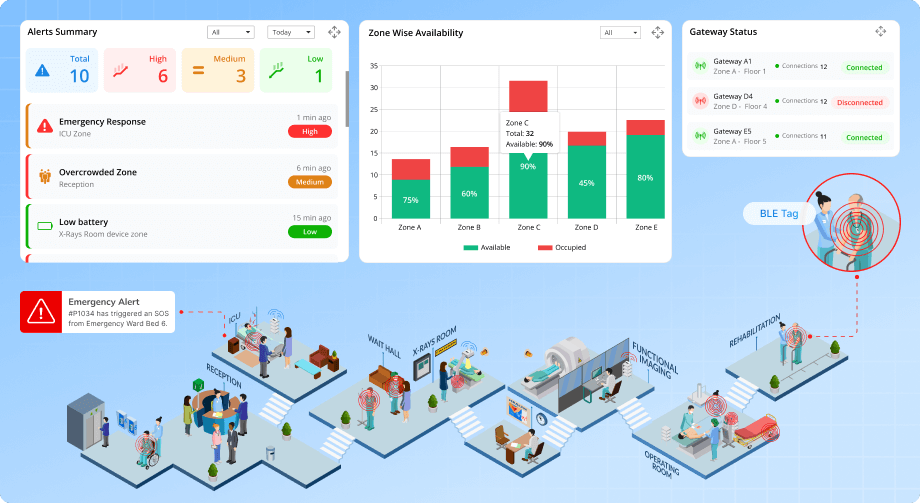Hospitals and healthcare centers are high-pressure environments where safety, speed, and coordination are critical. With multiple departments, large staff teams, and constant patient movement, managing indoor operations in real time becomes a major challenge. These facilities demand systems that support continuous monitoring, faster decision-making, and seamless communication across zones.
Making Hospital Operations Smoother with Indoor Tracking
Introduction
Challenges
- Locating patients or staff during emergencies is time-consuming: In multi-floor hospitals, it becomes difficult to find patients or staff without a real-time tracking system.
- Limited visibility in sensitive zones like ICUs and isolation wards: Movement in critical areas needs to be monitored for hygiene, safety, and operational control.
- Delayed response in emergency situations: Staff may not be aware when a patient needs urgent help, especially in large or crowded hospital facilities.
- No accurate log of patient or staff movement: Manual tracking fails to provide zone-wise visit records or duration of stay in specific departments.
- Non-compliance with safety and audit requirements: Without digital records, hospitals face difficulty in producing accurate reports for audits or quality checks.
- Lack of SOS alert mechanism for patients: In emergency situations, patients have no quick way to signal distress or request urgent help from the medical team.
Solution with Indoor Tracking Software
- BLE-based tracking tags for patients and staff: Each individual is assigned a BLE tag, allowing real-time tracking across hospital zones and floors.
- Live dashboard with zone-wise location visibility: Admins can monitor which patient or staff is in which zone/floor, updated in real time.
- Zone visit summary and duration tracking: The system records entry/exit time, total time spent in departments (like ICU, ward, lab), and movement patterns.
- Gateway status monitoring: Ensures that gateways installed in different locations (floors, wards, buildings) are online and functional.
- Alert system for critical events: Triggers alerts for conditions like
- Zone in/out entry
- Overcrowding
- Low signal
- Device battery low or offline status
- SOS feature for emergency alerts:
- Patients are given devices with an SOS button.
- In emergencies, pressing the button immediately alerts monitoring staff via the dashboard and alert reports.
- The system logs the exact zone and floor from where the SOS was raised, enabling rapid medical response.
Results Achieved
- Improved emergency response: SOS alerts help staff act immediately, minimizing critical delays in patient care.
- Real-time location awareness: Enables faster decisions by knowing exactly where each patient and staff member is at any moment.
- Better safety and accountability: Track and validate staff presence in high-care zones and ensure protocols are followed.
- Automated reports for compliance: Provides downloadable reports on zone visits, duration, alerts, and device activity—helpful for audits and hospital management.
- Efficient operations and workload management: Helps assign and monitor staff movement, improving overall productivity.
- Enhanced patient care and satisfaction: Patients feel safer knowing they can reach help instantly with the SOS button, especially during night hours or in isolated wards.




